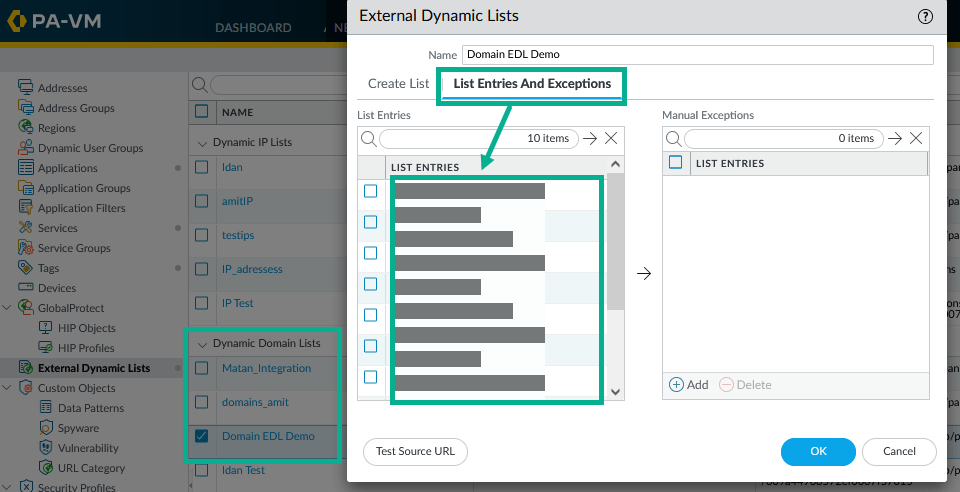Palo Alto Networks Panorama
Configure a Palo Alto Network Panorama on-premises device to pull IOCs from Digital Risk Protection (Threat Command).
The following table shows device-specific integration characteristics:
| Characteristic | Description |
|---|---|
| IOC types | Domains, IP addresses, and URLs. |
| IOC group limitation | Each IOC group can contain only one type of IOC. For multiple types, create multiple IOC groups. |
| Device IOC limit | The device is limited to 250,000 IOCs. |
To integrate the device, perform these steps (described in the following sections):
- Add the device to the Digital Risk Protection (Threat Command) virtual appliance.
- Configure the device to pull IOCs from Digital Risk Protection (Threat Command).
Add a Palo Alto Networks Panorama on-premises device
The procedure to add the device to Digital Risk Protection (Threat Command) is different depending on the version of the Digital Risk Protection (Threat Command) virtual appliance in your environment. To determine which version is running, see Determine the Version of Virtual Appliance.
Add the on-premises device
Add the device in virtual appliance v3.9
Prerequisites:
- The Digital Risk Protection (Threat Command) virtual appliance web interface is configured and you can access it.
- You have the credentials to access the device.
- You have administrative credentials to access Digital Risk Protection (Threat Command) with a subscription to the Automation and TIP modules.
To add the device to Digital Risk Protection (Threat Command):
- From an internet browser, navigate to https://<virtual appliance IP address>
- Log in to the virtual appliance using the web access username and password.
- From the Devices page, click Devices (Pull).
- Click Add new device.
- In the Devices (Pull) screen, set up the new device:
- Type a user-defined, unique device name.
- Select the device type.
- Click Create.
- Verify that the new device was added:
- Log in to Digital Risk Protection (Threat Command) at https://dashboard.ti.insight.rapid7.com
- From the main menu, select Automation > Integrations.
If this window is already open, refresh it by selecting Automation > Integrations from the menu.
The new device is displayed in the On-Premises tab.
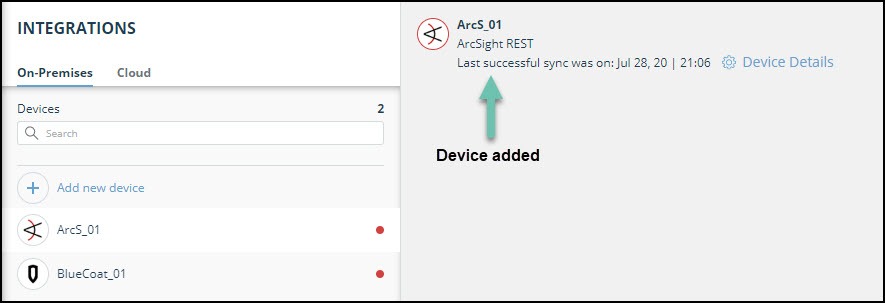
Add the device in virtual appliance v4.0
Prerequisites:
- You have the credentials to access the Digital Risk Protection (Threat Command) virtual appliance web interface.
- You have the credentials to access the device.
- You have administrative credentials to access Digital Risk Protection (Threat Command) with a subscription to the Automation and TIP modules.
To add the device to Digital Risk Protection (Threat Command):
- Log in to Digital Risk Protection (Threat Command) at https://dashboard.ti.insight.rapid7.com
- From the main menu, select Automation > Integrations.
- From the Integrations page, click On-Premises.
- Click Add new device.
- In the Add New On-Premises Device dialog, type a user-defined name for the device.
The name can contain a maximum of 50 letters, spaces, numbers, and underscores. - Select the Device type.
The default device IOCs limit is displayed. - (Optional) You can change the IOCs limit.
- Click Add.
- To verify that the new device is added, refresh the Automation > Integrations page.
Next to the device name, there is a red dot, indicating that communication has not yet been established. The dot will change to green when the device is synchronized. If the device cannot synchronize for more than 48 hours, an email warning is sent to the account administrator.
Configure a Palo Alto Networks Panorama device to pull IOCs
After a device has been added to the Digital Risk Protection (Threat Command) virtual appliance, you must enable it to pull IOCs from Digital Risk Protection (Threat Command).
Configuration for on-premises devices
When configuring an on-premises device, it is important to know which version of the Digital Risk Protection (Threat Command) virtual appliance is running in your environment. This will affect which Rapid7 URL is displayed in the Device Details screen and also which URL to copy into the device management console.
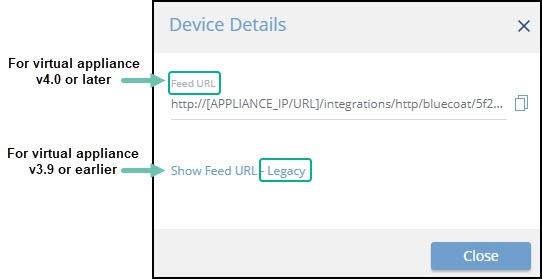
When running version 4.0 or later, the Legacy URL should be used only with Rapid7 support.
To determine which version of the virtual appliance is running, see Determine the version of virtual appliance.
Prerequisites
-
You have the device login credentials.
-
The device has been added.
-
You have administrative credentials to access Digital Risk Protection (Threat Command) with a subscription to the Automation and TIP modules.
-
An IOC group for this device exists in Digital Risk Protection (Threat Command).
Creating IOC groups is described in Create an IOC group -
Ensure that HTTPS port 80 and 443 are available.
Palo Alto Panorama uses External Dynamic Lists (EDL) to pull IOCs from Digital Risk Protection (Threat Command). You must create EDLs for each IOC type (URL, IP or domain), then, you create a security policy to use the EDL to pull IOCs.
The two-step process is described in the following procedures.
To create Palo Alto External Dynamic Lists:
The create EDL process is identical for each type of IOC.
- Log in to the Palo Alto Networks dashboard via HTTPS.
- Choose Objects > External Dynamic Lists.
- Click Addto create a new EDL:
- Type a name for the EDL.
This name will be used in the following step. - From the Type field, select a type: IP List, Domain List, or URL List.
The type must match the type in the IOC group. - In the Source field, paste the entire value from the Digital Risk Protection (Threat Command) IOC Group URL. - Be sure to replace [APPLIANCE_IP/URL] with the IP address of the virtual appliance:
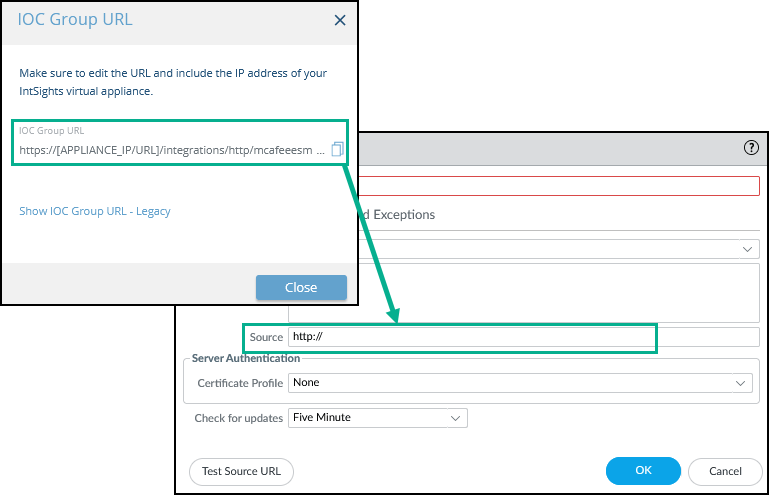
- Click OK.
- Click Commit.
- Type a name for the EDL.
Continue to the section for your IOC type.
To import URLs (EDL of type URL List):
- From the Palo Alto main menu, choose Objects > Security Profiles > URL Filtering.
- Click Add.
- In the URL Filtering Profile dialog, type a name.
- In the External Dynamic URL Lists section, select the EDL created for URLs and click OK.
- From Policies > Security, click Add.
- In the Security Policy Rule dialog, type a name for the new policy.
The Rule Type should be universal (default). - In the Source tab, select Any and select Source Zone.
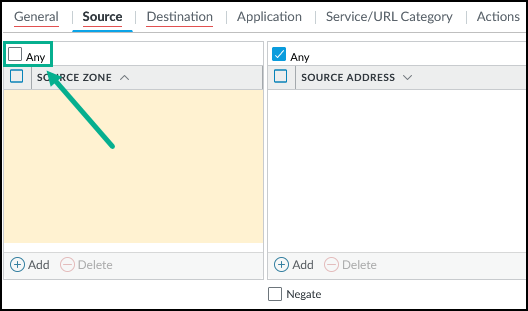
- In the Destination tab, select any from the drop-down list, and mark DESTINATION ZONE.

- In the Application tab, select Any.
- In the Service/URL Category tab, click Add.
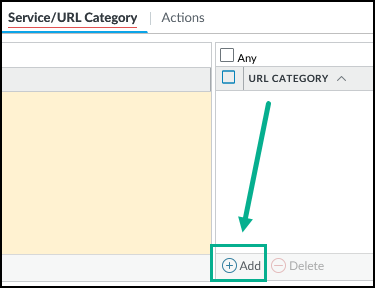
- From the list that opens, in the External Dynamic Lists section, select the EDL that was created for URLs.
- Click OK.
- From Policies > Security, select the new policy, then click Enable on the bottom menu.
- Click Commit.
When IOCs are present, you can see them at Objects > External Dynamic Lists. Select the EDL and look in the List Entries And Exceptions tab:
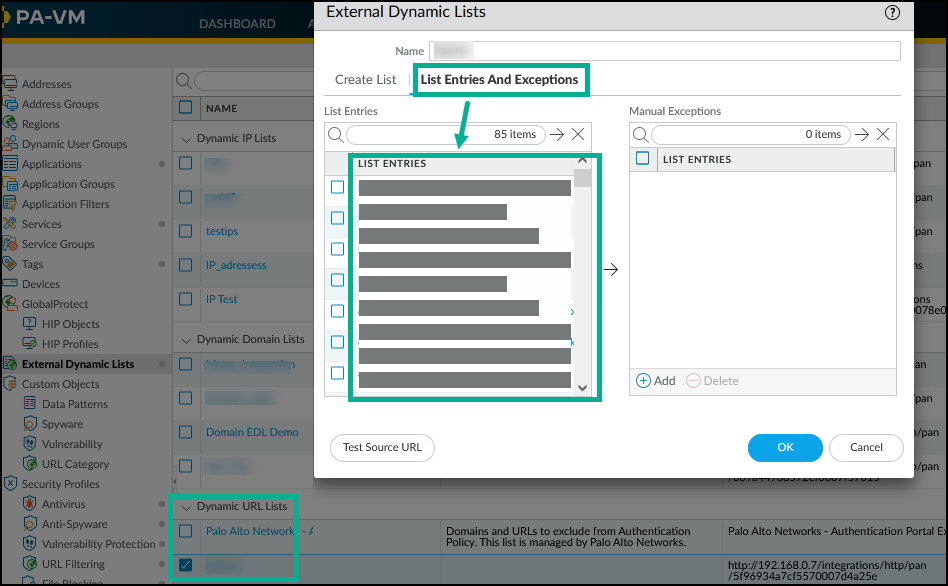
To import IP addresses (EDL of type IP List):
- From the Palo Alto main menu, choose Policies > Security.
- Click Add.
- In the Security Policy Rule dialog, type a name for the new policy.
The Rule Type should be universal (default). - In the Source tab, select SOURCE ZONE and Any above it**.**
- In the Destination tab, click Add.
- From the list that opens, in the External Dynamic Lists section, select the IP List EDL from the drop-down.
- In the Application tab, select Any.
- In the Service/URL Category tab, click Any for URL CATEGORY and for SERVICE.
- Click OK.
- From Policies > Security, select the new policy, then click Enable on the bottom menu.
- Click Commit.
When IOCs are present, you can see them at Objects > External Dynamic Lists. Select the EDL and look in the List Entries And Exceptions tab:

To import domains (EDL of type Domains List):
- From the Palo Alto main menu, choose Objects > Security Profiles > Anti-Spyware.
- Select the strict profile, then click Clone, and OK.
- Click the new profile.
- In the Anti-Spyware Profile dialog, type a name over the cloned name.
- In the DNS Policies tab, select the EDL for domains, then click OK.
- From the main menu, choose Policies > Security.
- Click Add.
- In the Security Policy Rule dialog, type a name for the new policy.
The Rule Type should be universal (default). - In the Source tab, select Any for SOURCE ZONE.

- In the Destination tab, select any from the drop-down list and select ZONE.
Also click Any for ADDRESS and select any in DEVICE.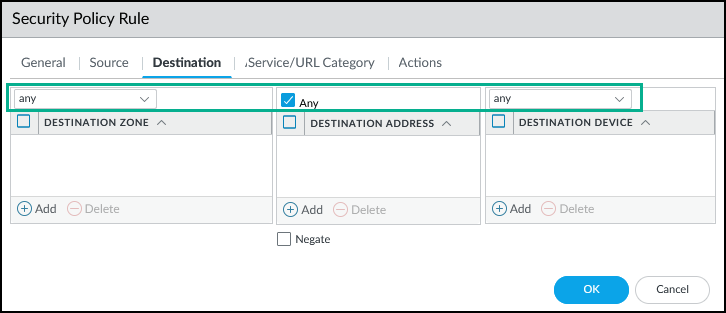
- In the Application tab, select Any.
- In the Service/URL Category tab, select Any from the drop-down list.
- In the Actions tab, in the Profile Setting section, for Profile Type, select Profiles.
- For Anti-Spyware, select the Anti-Spyware profile that you created (the one that you cloned from another).
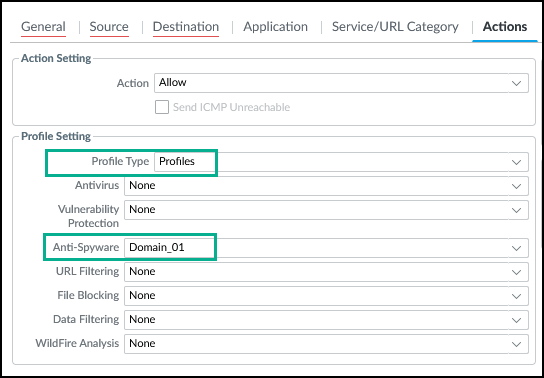
- Click OK.
- From Policies > Security, select the new policy, then click Enable on the bottom menu.
- Click Commit.
When IOCs are present, you can see them at Objects > External Dynamic Lists. Select the EDL and look in the List Entries And Exceptions tab:
